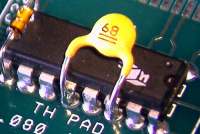Some of the odd twists and turns occasionally needed to modify assembled circuit boards can be surprising. Modifications that might seem almost ridiculous or jury-rigged at first glance are often quite acceptable and reliable.
Stacking components, mounting them upside down, or placing them end to end are just a few examples of the wide range of unique modifications that involve components on assembled circuit boards.
Figures 1 and 2 depict circuit board modifications involving components that will soon become part of IPC-documented guidelines.
Let's review some of the guidelines involving circuit board modifications and component additions:
- Added components may need to be secured with adhesive or other means if the component leads or body will be subjected to mechanical stress.
- Leads of added components should not be inserted into plated holes if the hole already contains a component lead.
- Added components placed on the circuit board surface should be placed on the component side of the assembly or circuit board unless otherwise specified.
- Added components shall not be raised above the board surface beyond allowable dimensions.
- Added components shall not cover over pads or vias used as test points.
- Added components shall not cover other component footprints unless the layout of the assembly prohibits mounting in other areas.
- Added component leads may require insulation to avoid contact with the component body or other conductors.
- Removal of existing solder in the connection may be necessary to avoid bridging or excess solder in the final connection.
- When stacking or mounting them adjacent to each other, consider conditions that may cause thermal problems.
- Observe proper lead forming to avoid damage to component leads or component body.
- When possible, component markings should be visible.
Several members of the Circuit Technology Center team contributed to this feature story. Images may be altered or recreated to protect proprietary information.
Images



Figure 1: Radial lead component soldered to through hole component leads.

Figure 2: Axial lead component soldered to through hole component leads.
















